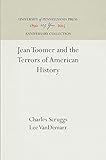Jean Toomer and the Terrors of American History / Charles Scruggs, Lee VanDemarr.
Material type: TextSeries: Anniversary CollectionPublisher: Philadelphia : University of Pennsylvania Press, [2016]Copyright date: ©1999Edition: Reprint 2016Description: 1 online resource (320 p.)Content type:
TextSeries: Anniversary CollectionPublisher: Philadelphia : University of Pennsylvania Press, [2016]Copyright date: ©1999Edition: Reprint 2016Description: 1 online resource (320 p.)Content type: - 9780812234510
- 9781512806656
- online - DeGruyter
- Issued also in print.
| Item type | Current library | Call number | URL | Status | Notes | Barcode | |
|---|---|---|---|---|---|---|---|
 eBook
eBook
|
Biblioteca "Angelicum" Pont. Univ. S.Tommaso d'Aquino Nuvola online | online - DeGruyter (Browse shelf(Opens below)) | Online access | Not for loan (Accesso limitato) | Accesso per gli utenti autorizzati / Access for authorized users | (dgr)9781512806656 |
Browsing Biblioteca "Angelicum" Pont. Univ. S.Tommaso d'Aquino shelves, Shelving location: Nuvola online Close shelf browser (Hides shelf browser)

|

|

|

|

|

|

|
||
| online - DeGruyter The Appreciation of Ancient and Medieval Science During the Renaissance (1450-1600) / | online - DeGruyter The Social Use of Metaphor : Essays on the Anthropology of Rhetoric / | online - DeGruyter Crisis and Continuity : Land and Town in Late Medieval Castile / | online - DeGruyter Jean Toomer and the Terrors of American History / | online - DeGruyter The Shaping of Somali Society : Reconstructing the History of a Pastoral People, 1600-1900 / | online - DeGruyter The Knowledge of Childhood in the German Middle Ages, 1100-1350 / | online - DeGruyter Designs of Darkness in Contemporary American Fiction / |
Frontmatter -- Contents -- Introduction: The Witness of History -- Chapter 1. Sparta -- Chapter 2. The New Metropolitan -- Chapter 3. Cultural Politics, 1920 -- Chapter 4. Whose America? -- Chapter 5. Writing Cane -- Chapter 6. The Gothic Detective Story -- Chapter 7. Cane in the City -- Chapter 8. The Black Man in the Cellar -- Epilogue: "An Incredibly Entangled Situation" -- Appendix: Jean Toomer's New York Call Articles -- Notes -- Acknowledgments -- Index
restricted access online access with authorization star
http://purl.org/coar/access_right/c_16ec
Jean Toomer's Cane was the first major text of the Harlem Renaissance and the first important modernist text by an African-American writer. It powerfully depicts the terror in the history of American race relations, a public world of lynchings, race riots, and Jim Crow, and a private world of internalized conflict over identity and race which mirrored struggles in the culture at large. Toomer's own life reflected that internal conflict, and he has been an ambiguous figure in literary history, an author who wrote a text that had a tremendous impact on African American authors but who eventually tried to distance himself from Cane and from his identification as a black writer. In Jean Toomer and the Terrors of American History, Charles Scruggs and Lee VanDemarr examine original sources--Toomer's rediscovered early writings on politics and race, his extensive correspondence with Waldo Frank, and unpublished portions of his autobiographies--to show how the cultural wars of the 1920s influenced the shaping of Toomer's book and his subsequent efforts to escape the racial definitions of American society. That those definitions remain crucial for American society even today is one reason Toomer's work continues to fascinate and to influence contemporary writers and readers.
Issued also in print.
Mode of access: Internet via World Wide Web.
In English.
Description based on online resource; title from PDF title page (publisher's Web site, viewed 27. Sep 2021)


